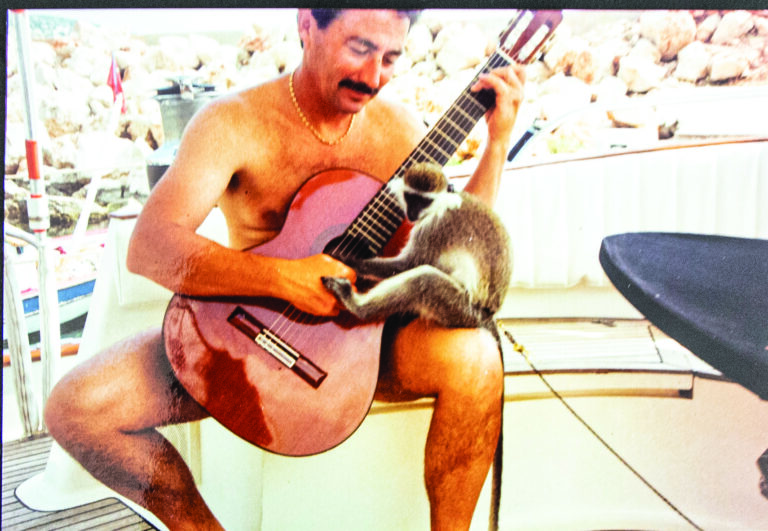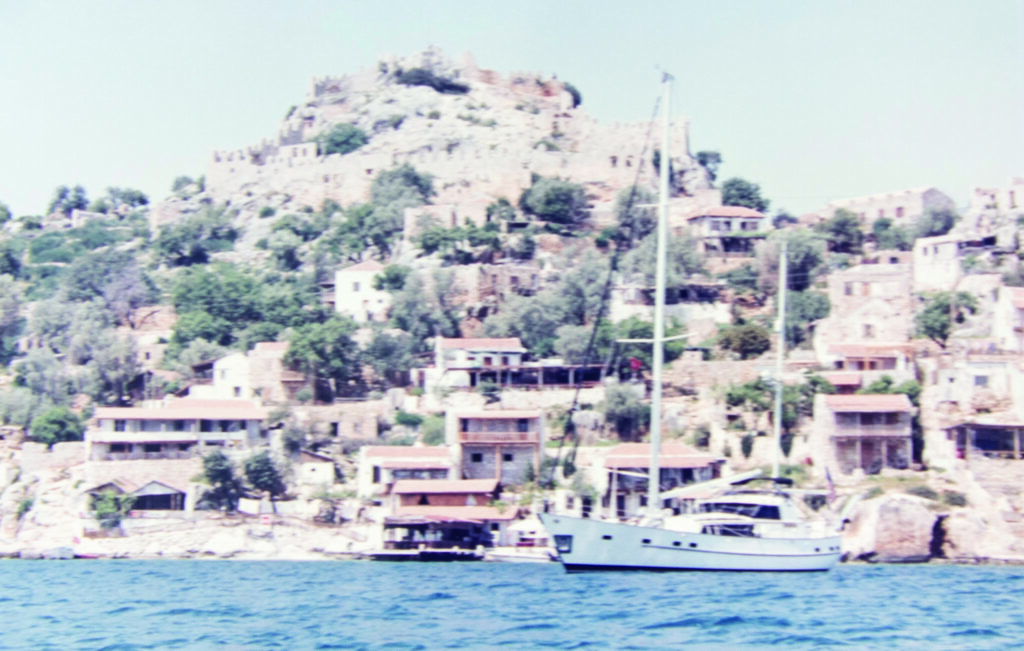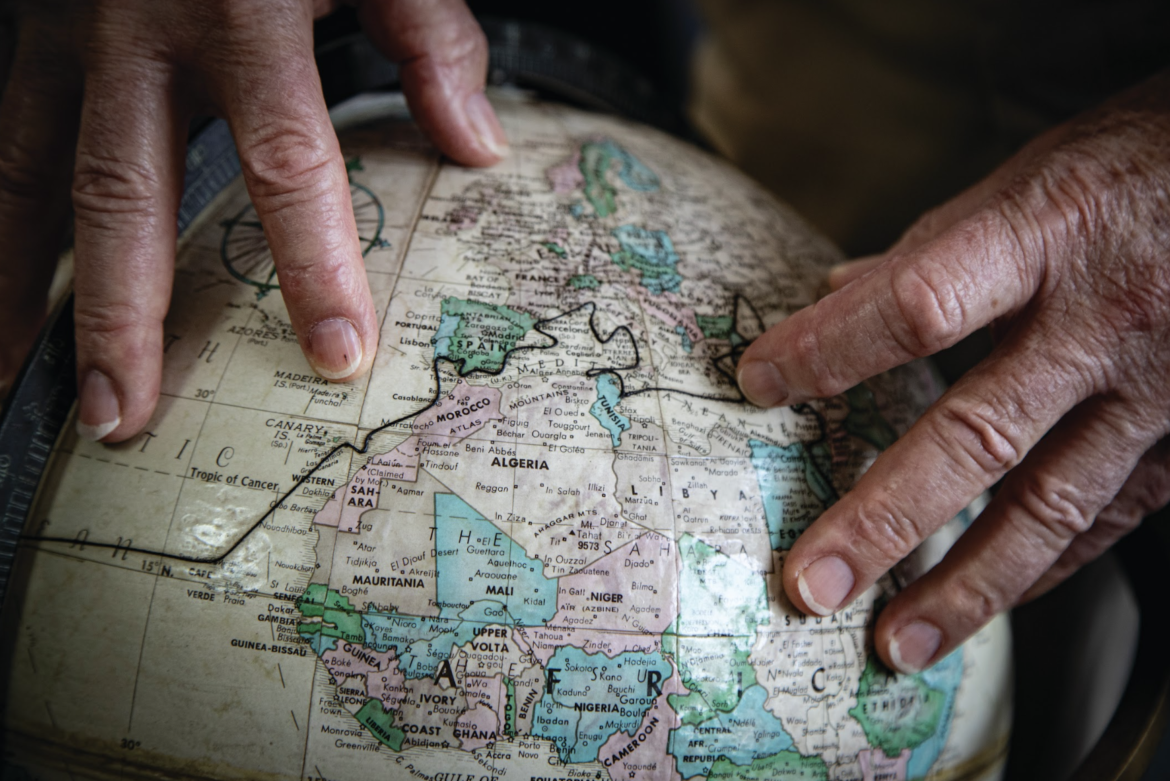What started as a 4-month cruise to Mexico turned into a made-for-Hollywood, 13-year voyage around the world. As told to Daniel Harding Jr.
I’d met Roger Moore a few times in passing. The founder of the Nautical Ventures–a boat dealer powerhouse that sells some of the biggest brands–almost always has an easy smile etched in a trimmed, salt and pepper goatee along with a bright orange polo, a marketing tool he created to help his team stand out on the docks and at boat shows. The few times I met him, the master conversationalist had a glint in his yes and slight smirk while offering hints about an around-the-world-trip he and his wife undertook years ago.
I had a feeling that if we could sit uninterrupted, he would have an unbelievable story to share, so I set an appointment to his corner office at his Ft. Lauderdale location (a converted BMW dealership on South Federal Highway). Over the next few hours Roger sat back and shared the story of his improbable trip around the world to me with a casualness that you and I would use when discussing the week’s weather. He explained how he and his late wife, Samantha, originally set out to cruise from California to Mexico over the span of a couple months aboard their 63-foot Cheoy Lee motorsailer. Spontaneity, love, an openness to adventure and a heaping dose of luck turned that coastal jaunt into a 13-year, around the world adventure that, if not for the photo evidence, you would think he was making up. What follows is but a taste of the once-in-a-hundred-lifetimes adventure he experienced. Let me warn you now, his story will likely inspire you to cruise beyond your own comfort zone.

Improbable Pacific Crossing
It was never my dream to go around the world. In 1986 we sold a business we’d built for 14 years and I said to my wife, “Hey, honey, why don’t we get a boat and cruise down the coast of California?” And she gave me this rather strange look saying, “What are you talking about?” But she was phenomenal. She would follow all my crazy ideas. So we bought a Cheoy Lee Motorsailer. But the intent was to take four months and to just cruise down the coast of California, gunkholing. We hit every port, every anchorage that you can hit. And we loved it, absolutely loved it. I remember the first time we anchored, she was petrified, this 130-pound anchor with I don’t know three-quarter-inch chain and all this. When it started to lower, it made a lot of noise and it was a lot of power. And she learned how to do that. And she learned how to do everything on the boat, as you’ll see, as this story unfolds and what ended up happening.
But we spent the four months cruising down the coast of California and looked at one another, said, “This is great. Let’s go to Mexico.” And she looked at me and said, “I love it. Let’s go.” So we gunkholed our way all the way down to Acapulco. And if you look I’ve got a globe here. If you look it’s a long way down, and then what do you do? Samantha would comment that NASA puts people on the moon with less planning than these people we met in Acapulco that were going to cross the Pacific. And when they mentioned it to me, I was not interested. It’s a 2,850-nautical-mile voyage with nothing in between. So it’s quite a commitment. I was not interested. That was not the goal. A month later, off we went. The captains, there were originally four of us, and we determined that the way we’d start this trip was based on waterline length so that when we were in the middle of the voyage, we’d be in the closest proximity to one another, so we could help one another. So we had a 63 Cheoy Lee. So we were the last to leave, having the longest waterline length and the highest speed.

One boat went down to try and pick up the southeast trades, another one went ahead of us, and the other boat opted out. They got nervous and didn’t go. So there were basically three of us that crossed. They all laughed at me because we had a motorsailer and they had pure sailboats. And I was over filling up what the generator burned the night before to make sure I had every drop of fuel that I could have on this voyage. And we held quite a bit. It was like 1,450 gallons or something, a lot of fuel. We leave from Acapulco. The boat name was Good Grief, and we take Good Grief out. And we’re about 12 hours into this voyage at night, and Samantha took the first watch. She was the night person. And as we were switching watch, I went down, and I go to step on the bed, and the carpet’s wet in the master stateroom. And I go, “Oh my God. How can this be?” So I taste it. It’s salt water. And I don’t want to say I panicked, but I said, “We’re only 12 hours into this multi-week journey. Let’s turn around.” And Samantha, man, it chokes me up thinking. She said, “Why don’t we just approach this like we were halfway? What would you do?” I said, “Well, we’ll figure out where it’s coming from.” And that was kind of an interesting thing. I started tearing out the furniture in the master cabin. I had a battery-powered saw. I cut the back of the settee out, and exposed that there was water coming from the aft bulkhead through a hole that they had produced at the factory. It had a six or eight-inch exhaust hose. And when they cut the hole, they just put a whole bunch of different holes and then punched the hole out. So there were all these sharp little triangles where the hole remained. So, what we did is we shut down that engine. We turned on the other engine, and I got a patch. I had some rubber material and some silicone, so I patched it, put some big hose clamps on it, and I think to this day it’s the same. Samantha was phenomenal. And we had biorhythms that were perfect because we’d do six on and six off. You hear of so many people, two on two off, and you don’t get any good sleep. It’s really tough on you. But six on and six off, it was perfect. We could have gone for six months. It was phenomenal. We’d have breakfast together. Whoever was tired, napped. And she learned to do the engine room inspections.

So, here we are about halfway and have to describe the three boats. We’re doing fine. The folks that went to pick up the southeast trades with a pure sailboat had all kinds of problems. They ran really low on fuel. They had to sail. They were in the doldrums. We had Ham radio contacts at noon and midnight every day to check on each other. And they were struggling. Then the other was a doctor and a nurse on a boat called Kahuna. And we were getting close to one another in the middle of the ocean. So we modified our courses, and we lowered sail. They swam over to my boat with line and a bottle of wine in the middle of the ocean. We had wine on the back deck, and their boat would disappear behind our boat. The seas are huge out there, but they’re big rollers. So they’d just disappear and then reappear. And here we are, two boats sitting in the middle of nowhere, and I said, “Well, how’s your trip going?” And they said, “It’s going great. But, man, we’re really low on water. It’s so hot. And we’re showering more often and trying to rinse off.” And I said, “Well, how many hoses have you got?” They had two. We had two. So we hooked the hoses together. I had a watermaker, so I filled their tank up in the middle of the Pacific Ocean. So, they were elated. I said, “Do you need anything else?” “No, we’re great.” So off we go, and we sail away. And the next day at noon, in the radio contact Jerry says, “Roger, there’s a helicopter hovering overhead.” And I said, “Jerry, are you hallucinating? There’s no helicopter that can make it 1,500 miles.” He said, “Shut up, Roger, there’s a helicopter here. I’ll call you back.” So we find out that there was a long-liner fishing boat out in the middle of the Pacific. And they have a helicopter that they send out to spot fish, and then they send their launches out to go fish them. So, when they saw this guy’s American flag, they said, “Do you need anything?” Well, they didn’t have the guts to ask me for fuel because they laughed at me when I was putting fuel in the boat. So, they dispatched one of the boats to them and gave them 30 gallons of diesel for nothing. And they brought two quarts of chocolate ice cream for them. So, here’s a boat that gets water, fuel and ice cream delivered in the middle of this journey.
Tonga
Tonga in the north island group called Vava’u. And we put down a mooring there, which was another whole experience, put down this mooring in a very safe place, considered a hurricane hole. And we spent seven months in Tonga. The stories about this were some really meaningful life stories. Where we were anchored in order to get fuel or food or whatever, we have to launch the dinghy and go ashore. So if you want to get fuel for the dinghy, you can figure six or seven hours. By the time you get it over there, take the tank out of the boat, hike up to the city, to the village and get the fuel and come back. So nothing happens quickly. But what else are you doing? So you’re living this adventure. And when I first got there, we really enjoyed watching videos on the boat.
So we brought a whole bunch of VHS tapes. Dating myself, right? And so I went to the video store and I met the owner of the video store and I said, “Hey, I got a deal for you,” because I like deals. And I said, “We’ve got a pretty nice video library, but I’ve seen them all. We’re going to be here for several months. I’m going to bring you my whole library. You can rent it, do whatever you want with it. And I get to pick whatever I want and I’ll use your library, and you don’t charge me anything. So, we both win.” So, we became really good buddies with this guy and his family. And so, we made this deal. It was fun. So he introduced us to his brother-in-law who owns the grocery store. And when I say grocery store, this is basic stuff.

So, we became very good friends, they had us over to eat and there’s dirt floors, kids running around naked, they eat and there’s food all over them and it’s a slice of life that we don’t really see, normal for them. And at one point they were so good to us. So nice to us, that I said to Samantha, I said, “Let’s have them out to the boat and have a nice Western dinner for them. Let’s show them another slice of life.” So they agreed, “Well, we’ll come out on Friday night.” I said, “Okay, great.” So, I go that day and they say let’s do next week.” So the next week comes, they can’t do it next week. And finally, I said, “Come on, we’re friends. What’s the problem here?” They said, “Well, you’ve invited us, but you didn’t invite our kids. We don’t go anywhere without our kids.” And I said, “Well, in America, if you’re invited to dinner with your friends, the kids are not invited.” I mean, this is an adult thing, an adult experience. And I’m imagining these kids on our boat. Three kids and we’ve got white carpet in the boat, and to have these kids walking around with food and I didn’t want to do it. Finally came up with an idea that we would take the boat to a close resort, and they would come join us and they’d swim out to the boat, so they’d all be clean, and they’d come out to the boat and we had dinner on the boat and they’d swam back. And the next thing that was amazing is when I told them it’s unusual for us to invite kids when it’s an adult party, they said, “I heard that when your parents get old, you put them in a home for somebody else to take care of them.”



